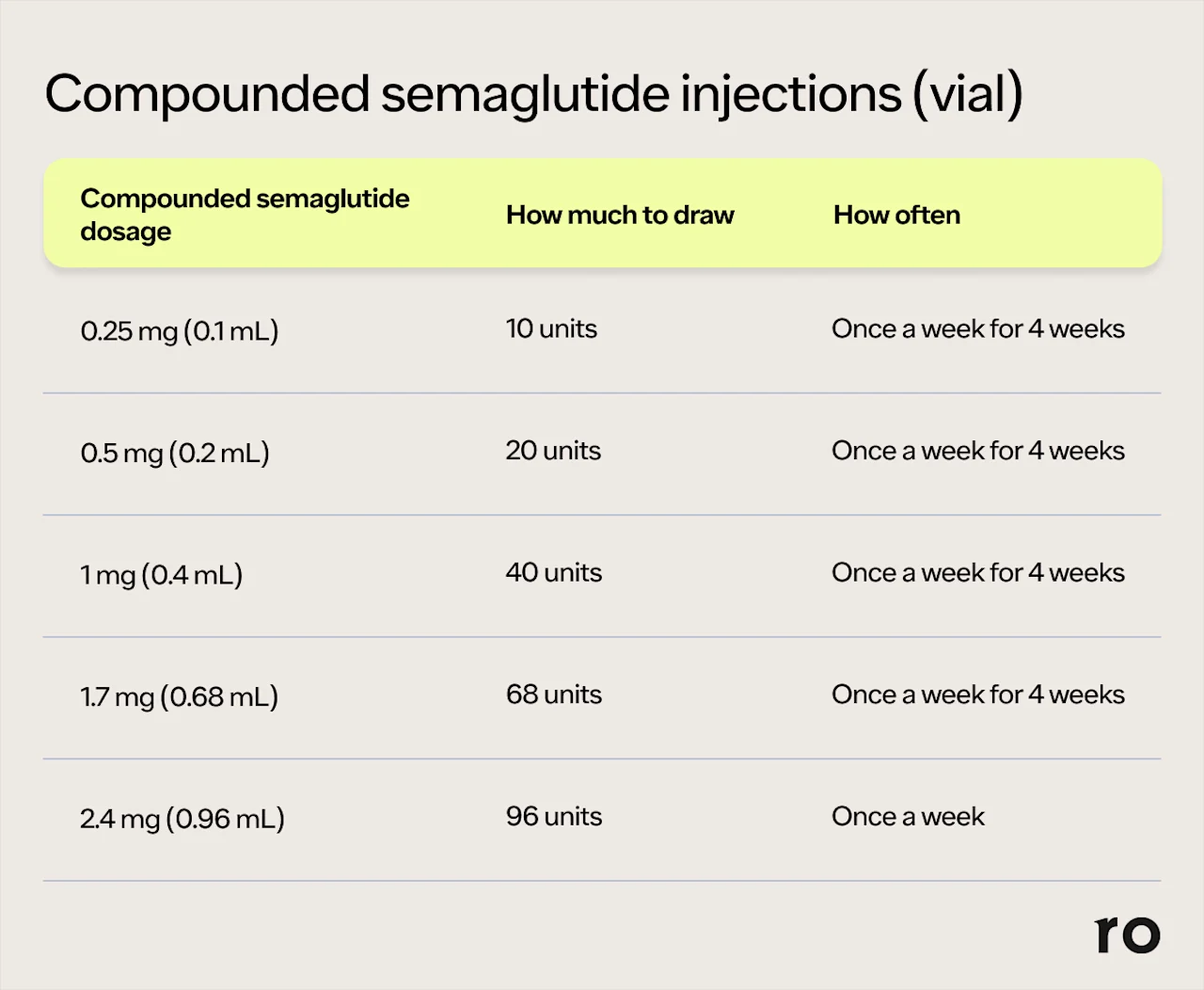Key takeaways
Semaglutide is a weekly injectable medication for type 2 diabetes, obesity, and some forms of heart disease, administered subcutaneously in the stomach, thigh, or upper arm.
Proper injection technique, including rotating sites and using sterile needles, ensures a full dose gets delivered and reduces complications.
Semaglutide pens and vials have specific usage and storage requirements to maintain effectiveness and safety.
Here's what we'll cover
Key takeaways
Semaglutide is a weekly injectable medication for type 2 diabetes, obesity, and some forms of heart disease, administered subcutaneously in the stomach, thigh, or upper arm.
Proper injection technique, including rotating sites and using sterile needles, ensures a full dose gets delivered and reduces complications.
Semaglutide pens and vials have specific usage and storage requirements to maintain effectiveness and safety.
Better known by the brand names Wegovy and Ozempic, semaglutide is a once-weekly injectable medication that treats type 2 diabetes, obesity, and heart disease. Whether you’re taking semaglutide for weight loss or to control your blood sugar levels, it’s important to know how to inject semaglutide.
The package insert that comes with your medication will include specific instructions for injecting semaglutide safely and effectively. But in case you’ve misplaced it, or you’d just like a refresher, we’ve put together this detailed guide on how to inject semaglutide.
Below, you’ll find step-by-step instructions for injecting semaglutide using a pen or a vial. We also answer common FAQs about injecting semaglutide, such as where to inject semaglutide and how to make sure you get your full dose.
How to inject semaglutide using a pen
Ozempic and Wegovy come in pen devices which make injecting semaglutide simple and convenient. Here’s how to inject semaglutide using a pen, including instructions for both Ozempic and Wegovy.
Note: Both Ozempic and Wegovy are injected weekly, but the pens work slightly differently. Ozempic pens contain multiple doses of semaglutide, so you’ll need to attach a new needle for each injection (see Step 3). Wegovy pens, on the other hand, each contain a single dose of Wegovy, and should be disposed of after one use.
Step 1: Gather your supplies
Before you inject semaglutide, you’ll need to gather the following:
Your pre-filled semaglutide pen
Alcohol swabs to clean the injection site
Gauze pad or cotton ball
A new, sterile needle for injection (Ozempic only)
Your sharps disposal container
Check that your pen contains your prescribed dose of semaglutide. The pens are color-coded to make this easier. For example:
Ozempic pens come with a red label (contains total of 2 mg equivalent to 6 doses of 0.25 mg starting dose or 4 doses of 0.5 mg maintenance dose); blue label (contains 4 doses of 1 mg maintenance dose); or yellow label (contains 4 doses of 2 mg maintenance dose). You can verify your pen has the correct dose by matching it to the colors shown here.
Wegovy pens with a light green label (0.25 mg starting dose); pink label (0.5 mg dose); brown label (1.0 mg dose); blue label (1.7 mg maintenance dose) or black label (2.4 mg maintenance dose). You can verify your pen has the correct dose by confirming it has the color shown in your WeGoTogether portal here.
Ensure the pen’s medication appears clear and colorless. If it’s cloudy, discolored, or contains particles, do not use it and contact your pharmacist. Air bubbles are okay.
Step 2: Wash your hands
Before injecting semaglutide, wash your hands thoroughly with soap and warm water and dry them with a clean towel. This reduces the risk of introducing bacteria into the injection site.
Step 3: Attach a new needle (Ozempic pen only)
Wegovy pens come with an attached needle, so if you’re injecting Wegovy, you can skip to Step 6. If you’re injecting Ozempic, keep reading.
Ozempic pens are designed to be used with NovoFine® Plus or NovoFine® disposable needles up to a length of 8 mm. Your carton of Ozempic should include enough needles for your Ozempic doses.
Remove the pen’s cap. Select a new needle from your carton, tear off the paper tab, and attach it to your pen by twisting it securely into place. Then, remove both caps from the needle. Throw away the inner needle cap, but hold on to the cap for the outer needle. You’ll dispose of this later in Step 8.
Always use a new needle for each injection to prevent contamination.
Step 4: Prepare the pen (Ozempic pen only, first-time use)
If you’re injecting Wegovy, skip to Step 6. If you’ve already used the Ozempic pen before, skip to Step 5. If this is your first time using this particular Ozempic pen, keep reading.
Each time you use an Ozempic pen for the first time, you’ll need to prepare it by checking the Ozempic flow. Here’s what to do:
Turn the dose selector until it shows the flow check symbol (this looks like two dots and a line).
Hold the pen upright with the needle pointing up.
Press and hold the dose button until the counter shows "0" and you see a drop of Ozempic at the tip of the needle. You should no longer see the flow check symbol.
If you don’t see a drop of Ozempic at the needle tip, repeat these steps up to 6 times (i.e. turning the dose selector to the flow check symbol, then holding the pen upright and holding the dose button until it shows "0"). If you’re still not seeing a drop, swap out the needle and repeat the process again one more time. If there’s still no drop, don’t use the pen and contact Novo Nordisk at 1-888-693-6742. The drop ensures that Ozempic can flow and you can receive your dose of semaglutide.
Step 5: Select your prescribed dose (Ozempic pen only)
Wegovy pens come with a single dose of the medication, so no dose selection is needed. If you’re injecting Wegovy, skip to Step 6. If you’re injecting Ozempic, keep reading.
Turn the dose selector until your prescribed dose appears (0.25 mg, 0.5 mg, 1 mg, or 2 mg). You’ll see vertical dashed lines before you see the dose, encouraging you to keep turning the selector. Double-check that the counter displays the correct dosage of semaglutide.
Step 6: Choose and clean your injection site
Choose an injection site. It can be your abdomen, thigh, or the back of your upper arm. If you choose to inject on the upper arm, it may be easier to have someone else do the injection for you.
Once you’ve chosen your injection site, clean the area with soap and water or an alcohol swab. Let it dry completely before moving on to the next step.
Step 7: Inject your dose of semaglutide
These next steps can differ depending on whether you are injecting Ozempic vs. Wegovy.
If you’re injecting Ozempic, insert the needle at a 90-degree angle into the skin of your injection site. Make sure you can see the dose counter and avoid covering it with your fingers. Then press down on the dose button and hold until the counter shows “0.” Keep the button pressed while you slowly count to six. Then remove the needle.
If you see any blood at the injection site, lightly press it with your gauze pad or cotton ball. Don’t rub the area.
If you’re injecting Wegovy, remove the pen cap by pulling it straight off. Then push the pen firmly into your skin at a 90-degree angle. Keep applying pressure until the yellow bar stops moving. (If it doesn’t start moving, press down harder on the pen.) You should hear two clicks during the injection. The first click tells you that the injection has started, and the second click tells you that it’s still going. When the yellow bar stops moving, your semaglutide injection is complete. It should take about 5–10 seconds total.
If you see any blood at the injection site, give it a light press with your gauze pad or cotton ball, but do not rub the area.
Step 8: Safely dispose of the pen and/or used needle
Now that your semaglutide injection is done, it’s time to safely dispose of your materials to avoid accidentally pricking yourself or others.
If you injected Wegovy, you can throw away the entire pen in your FDA-cleared sharps disposal container. Do not put it in your household trash.
If you injected Ozempic, carefully remove the needle from the pen and place it directly in your FDA-cleared sharps disposal container. If you don’t have a sharps container just yet, carefully replace the outer needle cap and hold onto it until you can dispose of the needle safely. Never put a used Ozempic needle in your regular household trash. If this was the last dose on your Ozempic pen, you can place it in the sharps disposal container too. If your pen still contains more doses, put the pen cap back on and store it for future use.
Speaking of storage, here are some tips on safely storing your semaglutide pens:
Keep your semaglutide pen in its original carton until you’re ready to inject it.
Before use, it’s important to store semaglutide pens in a refrigerator between 36°F and 46°F (2°C and 8°C).
If needed, Wegovy can be stored at room temperature (59°F to 86°F or 15°C to 30°C) for up to 28 days.
Once you’ve used the Ozempic pen, it can be stored at room temperature (59°F to 86°F or 15°C to 30°C) for up to 56 days. It can also be stored in the refrigerator at the temperatures mentioned above.
Avoid exposing semaglutide to direct sunlight or freezing temperatures.
How to inject semaglutide using a vial
If you’re prescribed compounded semaglutide, your medication may come in a small glass vial as opposed to a pen. Injecting semaglutide from a vial involves a bit more preparation than using a semaglutide pen, but the process is still pretty straightforward. Here’s how to inject semaglutide using a vial.
Gather your supplies
When injecting semaglutide using a vial, you’ll need:
Your vial of semaglutide
A sterile syringe and needle
Alcohol swabs to clean the injection site
A gauze pad or cotton ball
Your sharps disposal container
Before you start
Wash your hands with soap and water.
Double-check the information on the prescription bottle, including the dose amount and expiration date. The medication should be clear and colorless.
Filling the syringe
1. Gently shake the vial. If it's new, remove the plastic cap or, for a metal cap, remove the center circle and leave the rest of the cap in place. If it's not new, remove the seal sticker you placed before. Now, clean the top of the vial with an alcohol wipe.
2. On the syringe, remove the caps from the plunger and the needle. It’s important to keep the needle sterile, so do not touch it.

For example, if your dose is .25 mg, pull the plunger of the syringe down to the 10 units mark.
3. While holding the syringe with the needle pointed up, pull the plunger down to the correct dose. Use the chart above.
4. Insert the needle into the rubber part of the vial top and press down on the plunger to inject all of the air from the syringe into the vial. Injecting the air into the medication vial makes the next step easier!
5. While the needle is still in the vial, turn the vial upside down. Make sure the needle tip is surrounded by liquid. Pull back the plunger past your dose amount. For example, if your dose is 10 units of medication, pull the plunger back beyond the 10 units mark.
6. Remove any air bubbles by tapping the syringe with your finger.
7. Push the plunger to the prescribed dose level on the syringe. For example, if your prescribed dose is 10 units, push the plunger to the 10 units mark.
8. Turn the vial upright and then remove the needle.
9. Do not put the needle cap back on the needle. You can put the syringe down by resting it on the needle cap so the tip of the needle doesn’t touch anything.
10. Apply a new vial seal sticker to the cap of the vial after each use. Press firmly to ensure adherence to the cap to prevent against contamination.
Administering the injection
Select your injection site. Your abdomen (at least two inches from your belly button), front or outer thigh, or upper arm are all good injection sites, but choose a spot at least one finger’s width from the last injection spot.
Clean the area you want to inject with an alcohol wipe and allow the skin to dry.
Hold the syringe with the needle facing toward the ceiling. Push the plunger slightly until a drop forms at the end of the needle.
Pinch and hold the skin that you will inject. Next, holding the syringe pointing directly at the pinched skin, quickly push the needle through the skin, making sure to insert the entire length of the needle. Then slowly push the plunger to inject all of the medication.
Pull the needle out and clean the skin with an alcohol wipe or tissue. It’s normal to see a drop of blood at the injection spot. Press gently on the injection site for a few seconds to help stop the bleeding.
Safely discard the syringe
Discard the syringe in a sharps container or a heavy plastic container with a tight-fitting lid, like an empty detergent bottle. Do not throw away the syringe in your household trash.
Where to inject semaglutide
Semaglutide should be injected subcutaneously. That means you’ll give yourself a shot in the layer of fat beneath your skin, never a vein or muscle. Semaglutide can be injected in one of three areas: your stomach, thigh, or the back of your upper arm.
Here’s a bit more information about each injection site, plus tips on where to inject semaglutide.
Stomach: The stomach is the most common injection site because it’s easy to access and often has a good amount of subcutaneous fat. When injecting semaglutide into your stomach, inject at least two inches away from the belly button and avoid your waistline. This helps prevent irritation from your clothing.
Thigh: The front of the thigh is another option. Select a site midway between the knee and hip, avoiding the inner thigh. The outer upper thigh provides the best results.
Upper Arm: The back of the upper arm, between the shoulder and elbow, is another place you can inject semaglutide. However, you may need someone to help you, as this area can be difficult to reach on your own. Aim for the fleshy area on the outer back of the arm, at least 3 inches away from either your shoulder or elbow.
Here are a few more tips for choosing your semaglutide injection site.
Never inject semaglutide in the same spot as other medications, such as insulin. You can use the same area of the body, but don’t inject them right next to each other or in the same spot.
Rotate through your injection sites each time you inject semaglutide. You have five general areas to choose from: both upper thighs, both upper arms, and your stomach. You don’t have to use all of these, but you should choose a new area each week. This rotating through the different sites can lessen any discomfort or irritation you feel. It also helps prevent scar tissue from forming at any particular injection site.
When choosing an injection site, avoid injecting semaglutide in any part of your skin that is injured, swollen, or scarred.
How often should you rotate semaglutide injection sites?
Ideally, you should rotate through the semaglutide injection sites weekly, with each injection of semaglutide. You can rotate in any order you want: thigh to thigh, upper arm to stomach, stomach to thigh, and so on. You don’t even have to use all of the areas, as long as you are regularly rotating through the sites. If you’re injecting semaglutide yourself, for instance, you might have trouble reaching the back of your upper arm—so you can rotate through both of your thighs and abdomen instead.
What is the best place to inject semaglutide?
Other than the three semaglutide injection sites (stomach, thigh, upper arm), there is no “best place” to inject semaglutide. The best place is whichever spot makes it easiest for you to deliver your dose of semaglutide. The stomach can be a popular option because it tends to have more fat, which makes it both easier to administer the injection and less painful.
Does it matter where you inject semaglutide?
There are three recommended injection sites for semaglutide: stomach, thigh, and upper arm. Among these, you want to choose a spot that has fatty tissue and is easy for you to access. If you’re using your stomach, inject at least two inches away from your belly button. If you’re using your upper arm, choose a fleshy area in the back at least three inches from either your elbow or your shoulder. If you’re using your thigh, inject on the outer upper thigh, not the inner thigh.
How to make sure you get your full semaglutide dose
As with any medication, you want to ensure you’re getting your full dose of semaglutide. But, it can be a bit tougher to know you’ve received the full dose when you’re injecting the medication, as opposed to a pill you swallow. Here are a few ways to make sure you get your full semaglutide dose every time.
Verify the dose: For semaglutide pens, check that the dose counter is set to the correct amount prescribed by your healthcare provider. For vials, measure the dose precisely using a sterile syringe.
Inject semaglutide properly: Insert the needle into the skin at a 90-degree angle. Press the pen’s dose button firmly until the counter reads “0” (Ozempic) or the yellow bar stops moving (Wegovy). If using a syringe, gently push the plunger until all the medication is delivered.
Hold the needle in place: When using a semaglutide pen, keep the needle under the skin for at least six seconds after Ozempic, or up to 10 seconds for Wegovy.
Use a new needle each time: This not only reduces your risk of infection, but it also prevents leakage. And, blocked needles can lead you to give yourself the wrong dose. interfere with the full dose from being delivered.
Check the flow with each new pen (Ozempic only): Always check the flow the first time you use an Ozempic pen following the instructions in the medication insert.
Bottom line: how to inject semaglutide
Semaglutide is administered via a weekly subcutaneous injection into the layer of fat beneath the skin of the stomach, thigh, or upper arm.
The specific instructions for injecting semaglutide depend on whether you are using a multi-dose Ozempic pen, a single-dose Wegovy pen, or a vial of compounded semaglutide.
Ozempic pens require attaching a new needle for each use, while Wegovy pens come preloaded for single use. Compounded semaglutide in vials requires syringes for dosing, which involves more preparation.
Rotate through the injection sites each week to prevent discomfort, irritation, and scar tissue formation.
To ensure you receive the full dose, inject semaglutide at a 90-degree angle, hold the needle in place for the recommended duration, and use a new, sterile needle each time to prevent contamination and blockage.
Frequently asked questions (FAQs)
Do you have more questions about injecting semaglutide? We have answers.
Is there a wrong way to inject semaglutide?
Yes, injecting into the muscle or vein instead of the fat layer can affect absorption and cause pain. Always follow the instructions provided with your semaglutide prescription and inject into the fatty part of your skin on the upper arm, thigh, or stomach.
When is the best time of day to inject semaglutide?
Thanks to semaglutide’s weeklong half-life, there is no specific best time to inject semaglutide. All you need to do is inject on the same day of the week each week.
Why do you inject semaglutide?
Technically, you can take oral semaglutide. It’s called Rybelsus, and is FDA-approved to treat type 2 diabetes. It is a GLP-1 medication just like Wegovy and Ozempic. However, research shows that injecting medication subcutaneously (under the skin) allows more gradual absorption into the bloodstream. This enables medications like Ozempic, Wegovy, and compounded semaglutide to be injected on a weekly basis, regardless of the time of day.
Why do you get a lump after injecting semaglutide—and what should you do?
If you notice a lump after injecting semaglutide, there could be a number of reasons why. You may be injecting in the same spot each week, reusing needles, or not injecting semaglutide properly. If you found yourself nodding your head at any of these reasons, here’s what to do instead:
Choose a new injection site each week, rotating through them each week.
Use a new, sterile needle with each injection.
Follow the injection instructions included with your semaglutide medication.
If your lump doesn’t go away, talk to a healthcare professional. While hard lumps or nodules are not known to be a side effect of semaglutide, there has been at least one case report.
What should you do if you miss a dose of semaglutide?
If you miss a dose of semaglutide, what you do next depends on how long it’s been since your missed dose. If your missed dose of Wegovy or Ozempic was within the last five days, take the dose as soon as you remember. If it’s been more than five days, skip that dose and take your next dose as scheduled. This helps you avoid taking too much Ozempic, Wegovy, or compounded semaglutide.
For more tips on sticking to your dosing schedule, read our guide to using Ozempic while on vacation.
When does a semaglutide vial expire?
Semaglutide vials should have an expiration date listed on them. The expiration date can vary depending on when it was produced by the compounding pharmacy. These dates typically range from 60 to 180 days, but always use the best by date on your vial to confirm when your semaglutide vial expires.
When does a semaglutide pen expire?
Assuming they’re stored properly (e.g. in the fridge, away from sunlight and extreme temperatures), semaglutide pens last until the expiration date listed on the pen (look for “EXP” on the label). After you’ve opened an Ozempic pen, it lasts for 56 days as long as it’s stored at room temperature or in the refrigerator. As for Wegovy, you should only open the pen once you’re ready to use it, as each pen contains a single dose of the medication.
DISCLAIMER
If you have any medical questions or concerns, please talk to your healthcare provider. The articles on Health Guide are underpinned by peer-reviewed research and information drawn from medical societies and governmental agencies. However, they are not a substitute for professional medical advice, diagnosis, or treatment.
Wegovy Important Safety Information: Read more about serious warnings and safety info.
Ozempic Important Safety Information: Read more about serious warnings and safety info.
Hearn, E. B. & Sherman, J. J. (2021). Injection-Site Nodules Associated With Once-Weekly Subcutaneous Administration of Semaglutide. Diabetes Spectrum: A Publication of the American Diabetes Association, 34(1), 73–75. doi: 10.2337/ds20-0033. Retrieved from https://pmc.ncbi.nlm.nih.gov/articles/PMC7887535/
Kim, H., Park, H., & Lee, S. J. (2017). Effective method for drug injection into subcutaneous tissue. Scientific Reports, 7(1), 9613. doi: 10.1038/s41598-017-10110-w. Retrieved from https://pmc.ncbi.nlm.nih.gov/articles/PMC5575294/
MedlinePlus. (2024). Drawing medicine out of a vial. Retrieved from https://medlineplus.gov/ency/patientinstructions/000530.htm
MedlinePlus. (2023). Subcutaneous (SQ) injections. Retrieved from https://medlineplus.gov/ency/patientinstructions/000430.htm
NovoMEDLINK. (2024). Pens & Needles. Novo Nordisk. Retrieved from https://www.novomedlink.com/diabetes/products/treatments/ozempic/dosing-administration/ozempic-pen.html
U.S. Food & Drug Administration (FDA-a). (2024). Highlights of Prescribing Information: Ozempic (semaglutide) injection, for subcutaneous use. Retrieved from https://www.accessdata.fda.gov/drugsatfda_docs/label/2024/209637s032lbl.pdf
U.S. Food & Drug Administration (FDA-b). (2024). Highlights of Prescribing Information: Rybelsus (semaglutide) tablets, for oral use. Retrieved from https://www.accessdata.fda.gov/drugsatfda_docs/label/2024/213051s018lbl.pdf
U.S. Food & Drug Administration (FDA-c). (2024). Highlights of Prescribing Information: Wegovy (semaglutide) injection, for subcutaneous use. Retrieved from https://www.accessdata.fda.gov/drugsatfda_docs/label/2024/215256s021lbl.pdf
Wegovy-a. (2024). How to Use the Wegovy Pen. Novo Nordisk. Retrieved from https://www.wegovy.com/taking-wegovy/how-to-use-the-wegovy-pen.html
Wegovy-b. (2024). Using the Wegovy Pen. Novo Nordisk. Retrieved from https://www.wegovy.com/dashboard/my-library/week-01-using-the-wegovy-pen.htm













